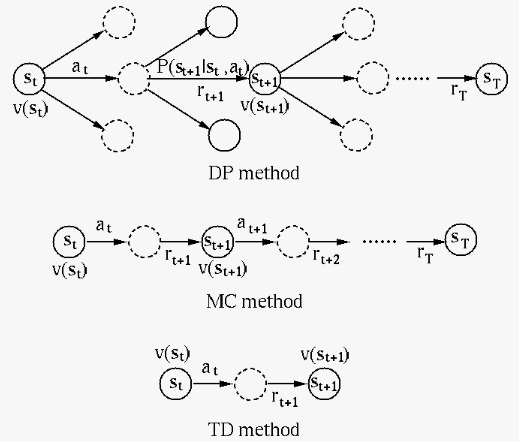Next: TD() Algorithm Up: Model-Free Evaluation and Control Previous: Monte Carlo (MC) Algorithms
The temporal difference (TD) method is a combinaion of the
MC method considered above and the bootstrapping DP method
based on the Bellman equation. The main difference between
the TD and MC methods is the target, the return 




 |
(51) |
Again, we first consider the simpler problem of policy
evaluation. As in the MC method, we estimate the value
function 

 , called the TD error, is the
difference between the TD target and the previous
estimate:
and
, called the TD error, is the
difference between the TD target and the previous
estimate:
and  is the current estimatee of the value
of the next state (bootstrapping). It can be shown that
the iteration of this TD method converges to the true
value
is the current estimatee of the value
of the next state (bootstrapping). It can be shown that
the iteration of this TD method converges to the true
value  , if the step size is small enough.
, if the step size is small enough.
Here is the pseudo code for policy evaluation using the
TD method, based on parameters 

 to be evaluated
to be evaluated
 for all
for all  arbitrarily,
arbitrarily,
 for terminal state
for terminal state  ,
,
![$\alpha\in(0,\;1]$](img289.svg)

 is not terminal (for each step)
is not terminal (for each step)
 , get reward
, get reward  and
next state
and
next state 
![$v(s)=v(s)+\alpha[ r+\gamma v(s')-v(s)]$](img291.svg)

As the TD algorithm updates the value function at every step of the episode, it uses the sample data more frequently and efficiently, and therefore has lower variance error than the CM method that updates the estimated value function at the end of each episode. On the other hand, the TD method may be biased when compared to the first-visit MC method, due to the arbitrary initialization of the value functions.
Based on the TD method for model-free policy evaluation,
we now further consider the TD method for model-free
control to gradually learn the optimal policy by updading
the Q-values of all state-action pairs 
The Q-values for all state-action pairs can be stored in a state-action table which is iteratively updated by running many episodes of the unknown MDP by the TD method to gradually approach the maximum Q-values achievable by taking each action at each state, i.e., the optimal action is the one with the highest Q-value.
This method has two different flavors, the on-policy
algorithm, which updates the Q-value by following the
current policy such as an 

The Q-value 






 |
 |
 |
|
 |
 |
(54) |
This algorithm is called SARSA, as it updates
the Q-value based on the current state 




 for all
for all  ,
,
![$\alpha\in(0,\;1]$](img289.svg) ,
,
 ,
denote
,
denote  -greedy policy
-greedy policy  by
by 

 according to
according to  based on
based on 
 is not terminal (for each step)
is not terminal (for each step)
 , get reward
, get reward  and next state
and next state 
 according to
according to  based on
based on 
![$q(s,a)=q(s,a)+\alpha [r+\gamma q(s',a')-q(s,a)]$](img301.svg)

As a variation of SARSA, the expected SARSA updates
the Q-value at state 


 |
(55) |
Same as SARSA, the Q-learning algorithm also estimates
the Q-value 






 |
(56) |
The pseudo code of SARSA algorithm is listed below.
 arbitrarily (
arbitrarily ( for terminal
for terminal  ),
),
![$\alpha\in(0,\;1]$](img289.svg) ,
,


 is not terminal (for each step)
is not terminal (for each step)
 according to
according to  based on
based on  ,
get reward
,
get reward  and next state
and next state 
![$q(s,a)=q(s,a)+\alpha [r+\gamma\max_{a'} q(s',a)'-Q(s,a)]$](img306.svg)

Here is the comparison of the MC and TD methods in terms of their pros and cons:
 ,
the expected return, by the true return
,
the expected return, by the true return  obtained
at the end of the episode, i.e., the estimated value is
updated once every episode;
obtained
at the end of the episode, i.e., the estimated value is
updated once every episode;
The TD method estimates



 is based on sample returns
is based on sample returns
 , and it is unbiased, while TD uses the
bootstrap approach to find the TD target based on sample
data that are not necessarily i.i.d., and it is more
sensitive to the initial guess of the value functions,
it is more biased.
, and it is unbiased, while TD uses the
bootstrap approach to find the TD target based on sample
data that are not necessarily i.i.d., and it is more
sensitive to the initial guess of the value functions,
it is more biased.
 affected by
many random events (state transitions, actions, and
rewards), and in particular the first-visit version of
the MC method only makes use of the sample data from
the first visit of a state, it does not use the available
data efficiently and it has high variance, while on the
other hand the TD method is based on only one random
variable, the estimated return, and it makes more
frequent and efficient use of the sample data, it has
lower variance.
affected by
many random events (state transitions, actions, and
rewards), and in particular the first-visit version of
the MC method only makes use of the sample data from
the first visit of a state, it does not use the available
data efficiently and it has high variance, while on the
other hand the TD method is based on only one random
variable, the estimated return, and it makes more
frequent and efficient use of the sample data, it has
lower variance.
Here is a summary of the dynamic programming (DP) method for model-based planning, and the Monte-Carlo (MC) and time difference (TD) methods for model-free control:
